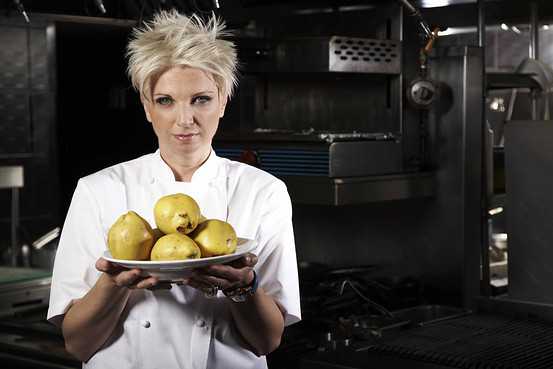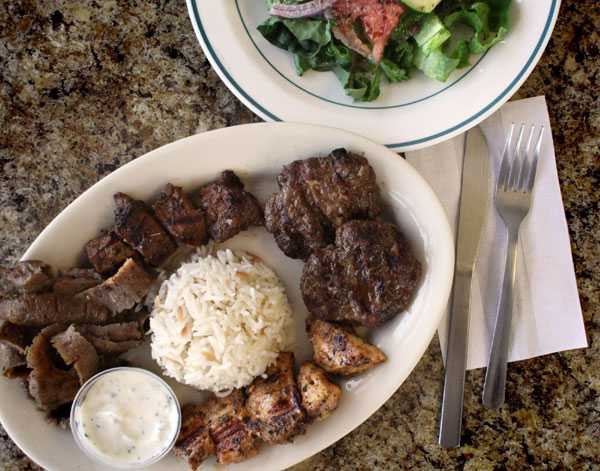Chef Silvena Rowe Slims Down Middle Eastern Cuisine
French cuisine went through a major slimming phase nearly 40 years ago—it was called cuisine minceur. Technically speaking, this low-calorie style was a refinement of nouvelle cuisine, which had begun the process of simplification and food presentation that still exists in France today. Old habits die hard, though, and in the late ’80s, my first olfactory impression of the great Georges Blanc in the Rhône-Alpes was that I had mistakenly stepped inside a dairy.

Such a revolution against butter and fat hasn’t really occurred in Middle Eastern cuisine, where both are essential elements of certain dishes. Then again, perhaps a case could be made that Lebanese, Persian and Turkish cuisine has never suffered the excesses of classic French haute cuisine. Even so, Silvena Rowe, a food writer and television chef from the fringes of the former Ottoman Empire, is determined to promote a reduced-fat and olive-oil path through Eastern Mediterranean cuisine. Last month, the author of “Purple Citrus & Sweet Perfume” opened a restaurant in London called Quince (www.quincelondon.com).
While the dishes at this bustling café-style establishment in the May Fair Hotel certainly look familiar, they have a flare that comes from Ms. Rowe’s individual approach. Take her jumbo tiger prawn with grapefruit and oregano dressing, Aleppo chili and za’atar (a mixture of Middle Eastern herbs and sesame seeds). It has a tart freshness that seems like it would be more at home in an expensive health spa than a traditional Middle Eastern restaurant. “It is more fragrant than spicy, but the important difference is that I don’t put any olive oil into it—it’s not needed,” she explained.
Ms. Rowe, a striking blonde born in Bulgaria to a Turkish father, started her career cooking and writing about Eastern European food but then decided to look further into her past. “I wanted to create something that was sexier and had more appeal in terms of taste, presentation and in the way of delivery,” she says. “I looked at myself, my way of eating and my heritage, and thought I may be East European but I am a Turkish-East European. So I went back to my roots and it all fell very nicely into place. Then I decided to travel around the eastern Mediterranean and rediscover the food. A lot of the food in Turkey, Syria and the Lebanon is very heavy peasant food, which was nonetheless delicious. But I decided if I was going to offer this to the British palate, it needed to be lighter and more sophisticated, and that’s what I did.”
At its apogee in the early 17th century, the Ottoman Empire had a monopoly on the overland routes of the spice trade and the kitchens of the Topkapi Palace in Istanbul employed nearly 1,400 people. Butter and lamb fat were a key part of local cuisine, with olive oil predominating along the Mediterranean coast, where it was introduced originally by Greek settlers.
This history hasn’t deterred Ms. Rowe from virtually eliminating oil and fats from her salads and sauces.
“Instead, I use tahini and pomegranate molasses, though not in the same recipe, of course,” she says. “My belly of pork with blueberry molasses is basically just a matter of taking a traditional dish, lightening it and then injecting it with interesting flavors.”
The same principle applies to her lamb and beef skewers, served with Ottoman spices, pistachio and spinach tzatziki. Like the king prawn dish, the lasting impression is of the lightness of what is typically a robust heavy dish. Rice, too, is steamed and mixed with dried fruits and spices, rather than butter, which is traditionally used to create a risotto-like dish in Turkish cuisine.
Ms. Rowe is unrepentant about her approach: “We are all very conscious about what we eat, and I don’t want to present food that at the end of the day just ends up on your hips. That is why with the filo pastry dishes, I reverse the usual roles and have far more filling than pastry.”
But others, like Engin Akin, a prominent Turkish food historian, question the chef’s ideas. Speaking from Istanbul, Ms. Akin says butter has a prominent and useful place in Ottoman cuisine. “It doesn’t overflow in our cuisine, but it is a necessary ingredient, especially in rice and risotto,” she says. “As for olive oil, that was introduced by the Greeks and is very handy, especially for certain vegetables.”
Nancy Harmon Jenkins, the American food writer and author of “The Mediterranean Diet Cookbook,” scoffs at the notion that fat-free Middle Eastern food is desirable in any sense. “That’s extremely retro,” she says. “Every scientific fact in the past decade suggests that a low-fat diet is utterly ridiculous; We need fat to metabolize quite a lot of vitamins. If your purpose in life is to lose weight, you just need to eat less calories, especially in carbohydrate form.” Ms. Jenkins thinks olive oil—which just so happens to be her area of expertise—is vital, along with butter and lamb fat, in traditional eastern Mediterranean cuisine.
But Ms. Rowe isn’t put off her mission by such talk. “Many Turkish chefs are snobby and stuck in the past,” she says. “I have also had complaints from a Lebanese customer about the fact that it was not traditional enough. I told him: ‘We are in the heart, or belly button, of London. I never said I was trying to open an ethnic restaurant.’ All I say is that I am of Ottoman origin and that I have gone back to my roots, but we are a deluxe eatery. My ultimate goal is to be the Nobu of Turkish cuisine.”
Write to Bruce Palling at [email protected]
via Bruce Palling on Food: The Reduced-Fat Diet – WSJ.com.

